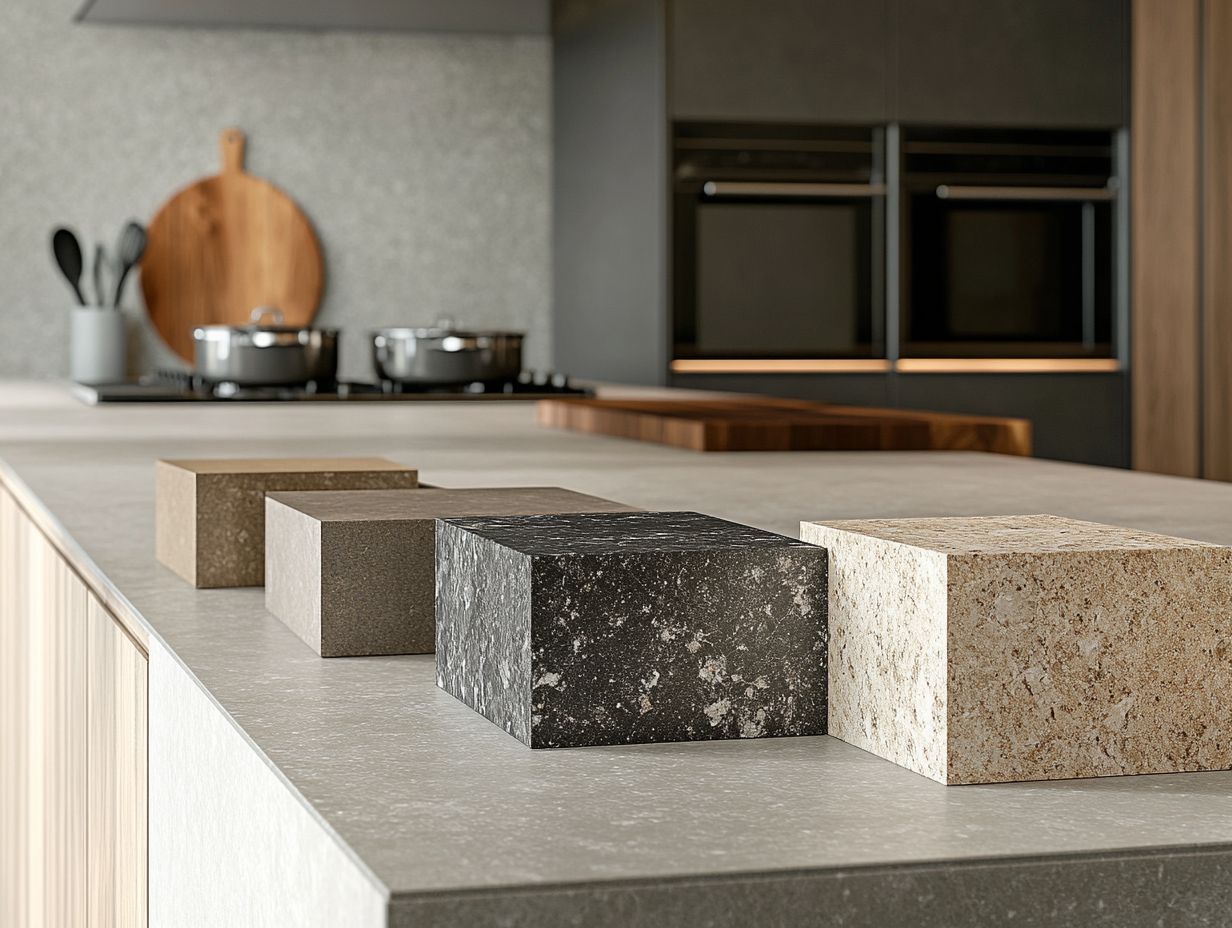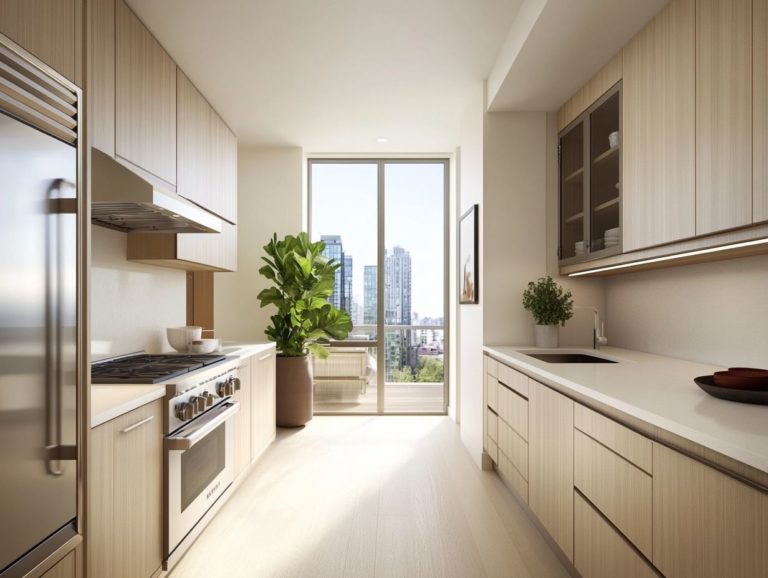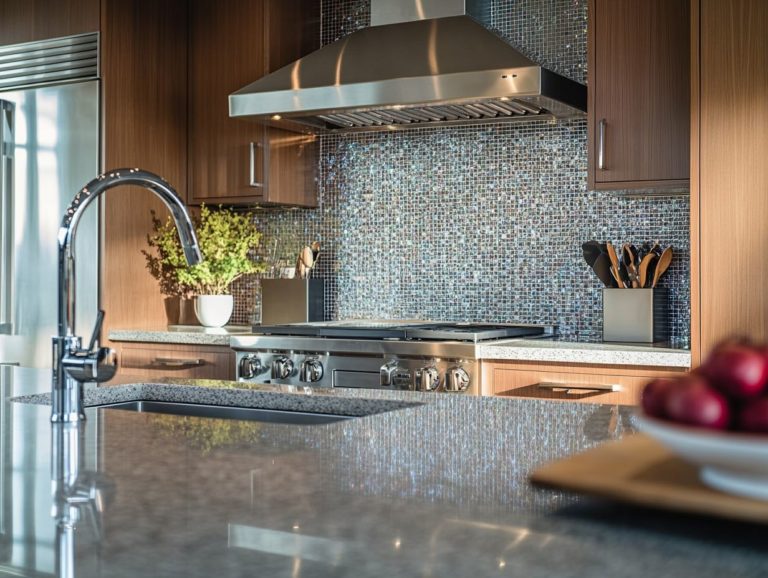How to Choose Heat-Resistant Kitchen Materials
In the bustling environment of your kitchen, the right materials can truly elevate your cooking experience, especially when heat resistance is a priority.
Understanding what makes a material heat-resistant is essential for your safety and the longevity of your kitchenware. This article explores various types of heat-resistant materials, weighing their pros and cons while offering insights to help you select the best options for your cooking needs.
From utensils to countertops, there are maintenance tips to keep your kitchen in impeccable shape. Prepare to transform your culinary space with informed choices that reflect both style and practicality!
Contents
- Key Takeaways:
- Understanding Heat-Resistant Materials
- Common Types of Heat-Resistant Materials
- Factors to Consider When Choosing Heat-Resistant Materials
- Best Heat-Resistant Materials for Different Kitchen Uses
- Tips for Maintaining Heat-Resistant Materials
- Frequently Asked Questions
- What are some common heat-resistant kitchen materials?
- What factors should I consider when choosing heat-resistant materials for my kitchen?
- Is silicone a good heat-resistant material for my kitchen?
- What makes stainless steel a good heat-resistant material for the kitchen?
- Are there any eco-friendly heat-resistant materials I can use in my kitchen?
- Is it important to choose heat-resistant materials for all my kitchen tools and appliances?
Key Takeaways:

- Choose heat-resistant materials that can withstand high temperatures and prolonged exposure to heat to ensure safety and durability in the kitchen.
- Consider factors such as heat tolerance, durability, cost, and maintenance when selecting heat-resistant materials to find the best option for your specific needs.
- Properly maintain heat-resistant materials by regularly cleaning and replacing damaged materials to ensure they continue to provide heat resistance and functionality in the kitchen.
Understanding Heat-Resistant Materials
Understanding heat-resistant materials is key to remodeling your kitchen. These materials play a crucial role in achieving a harmonious blend of functionality and aesthetic appeal.
Heat resistance is especially important for countertops, which face the daily demands of diverse cooking habits. Choosing the right materials can greatly affect the durability and longevity of your kitchen surfaces.
Seek professional advice when exploring your options to ensure that your selections meet your needs and elevate the overall design of your space.
What Makes a Material Heat-Resistant?
A material is considered heat-resistant if it can endure high temperatures without significant degradation, making it essential for kitchen applications where surfaces are often exposed to heat.
In the fast-paced environment of a kitchen, especially during intense cooking sessions, the durability of your countertops becomes crucial. Materials like granite, quartz, and ceramic stand out for their exceptional heat resistance, thanks to their unique structures that help them handle heat well.
For example, granite boasts a dense composition, allowing it to withstand hot cookware without warping or cracking. Similarly, quartz offers impressive thermal stability with a non-porous surface that resists stains and bacteria.
Understanding these properties not only helps you choose the ideal countertop but also complements your cooking style—whether you’re diving into intensive meal prep or enjoying leisurely gatherings on the weekend.
Common Types of Heat-Resistant Materials
Discover amazing heat-resistant materials that will transform your kitchen! Options include:
- Porcelain countertops
- Ceramic tile
- Granite
- Soapstone
- Stainless steel
- Quartz
- Quartzite
Each option brings its own distinctive advantages and aesthetic charm, allowing you to create a space that is both functional and visually stunning.
Pros and Cons of Each Material
When selecting countertops for your kitchen, consider the unique pros and cons of each type of heat-resistant material.
Granite, for instance, is durable and beautiful, making it a popular choice. However, it requires periodic sealing to remain resistant to stains.
On the other hand, quartz countertops come in a delightful array of colors and patterns, and they do not need sealing. However, some may find quartz to be less heat-resistant than natural stone options.
Laminate surfaces are budget-friendly and easy to clean, but they might not offer the same level of resilience and longevity as other materials.
By weighing these factors carefully, you can make informed choices that align with your lifestyle and aesthetic preferences, ensuring your kitchen remains both functional and visually stunning.
Factors to Consider When Choosing Heat-Resistant Materials

When selecting heat-resistant materials for your kitchen countertops, it’s essential to evaluate a few key factors:
- heat tolerance
- durability
- cost
- maintenance requirements
By taking these elements into account, you can ensure that you choose the ideal option that perfectly suits your needs.
Heat Tolerance and Durability
Heat tolerance is crucial for the durability and longevity of your countertops. This is especially important in kitchens, where high temperatures are common due to cooking.
Different materials, like granite, quartz, and laminate, have unique heat-resistant qualities. Consider how these surfaces react to immediate heat from pots and pans and their ability to withstand temperature changes.
For instance, while you might be drawn to granite for its natural robustness and aesthetic appeal, you could also find yourself leaning toward quartz for its engineered durability and superior heat resistance.
Evaluating these properties involves some research, reading reviews, and perhaps even consulting with professionals who can offer valuable insights based on their past installations.
Cost and Maintenance
The cost and maintenance requirements of heat-resistant materials can vary widely. It’s essential for you to evaluate your budget and willingness to engage in regular upkeep when choosing countertops.
You have a range of options at your disposal, from granite and quartz to butcher block and concrete, each presenting its unique set of advantages and challenges.
For example, while quartz might require less maintenance than natural stone, it often comes with a higher price tag—something that could influence your decision.
Knowing how often these surfaces need sealing or polishing can greatly impact your costs.
Many are now choosing materials that resist heat and also look great in their kitchens, ultimately influencing design choices and personal preferences.
Best Heat-Resistant Materials for Different Kitchen Uses
Choosing the best heat-resistant materials for your kitchen is exciting! Different applications require different qualities for top performance.
Cooking Utensils
Heat-resistant materials are essential for your cooking utensils, ensuring both safety and durability as they withstand high temperatures during food preparation.
You’ll find a variety of materials, including stainless steel, silicone, and certain ceramics, commonly employed for their exceptional heat-resisting properties.
Stainless steel, with its remarkable strength and non-reactive nature, can endure intense heat without warping.
Silicone, celebrated for its flexibility, not only withstands high temperatures but also prevents food from sticking, making it a go-to choice for both baking and cooking.
On the other hand, ceramic utensils offer a touch of aesthetic charm while being able to endure significant heat. The importance of these materials extends beyond mere functionality; they play a crucial role in kitchen safety, minimizing the risk of burns and elevating your overall cooking experience.
Countertops and Surfaces

Choosing the right heat-resistant materials for your countertops and surfaces is crucial in kitchen design, impacting both functionality and aesthetic appeal.
Understanding the various options available allows you to create spaces that are not only durable but also visually stunning.
Materials like granite and quartz are celebrated for their exceptional heat resistance, making them ideal for areas that experience high temperatures.
If you prefer a modern aesthetic, stainless steel surfaces offer a sleek look while ensuring easy maintenance and hygiene—perfect for any cooking environment.
Alternatively, concrete presents a unique and customizable option that can withstand heat, though it does require regular sealing to keep its appearance intact.
Weigh maintenance needs against looks to find the perfect fit for your kitchen.
Appliances
Incorporating heat-resistant materials into your appliances is essential, as they greatly enhance the overall efficiency and safety of your kitchen design.
Materials like silicone, tempered glass, and stainless steel are specifically engineered to endure high temperatures without degrading or posing any risks. For example, silicone handles on pots and pans allow you to cook at high heat without the fear of burns.
Using tempered glass in oven doors gives you a clear view of your food while enhancing safety by resisting thermal shock, which occurs when sudden temperature changes cause cracking.
Thus, the thoughtful selection of heat-resistant components in your kitchen appliances boosts performance and plays a crucial role in maintaining a safe cooking environment.
Tips for Maintaining Heat-Resistant Materials
Maintaining heat-resistant materials in your kitchen is crucial for extending their lifespan and preserving their aesthetic allure. This needs careful cleaning and care for each material.
By investing time in the proper maintenance, you ensure both functionality and beauty in your culinary space.
Proper Cleaning and Care
Proper cleaning and care are essential for keeping heat-resistant materials functional and visually appealing for years to come.
To achieve this, adopt specific cleaning methods tailored to each material. For instance, using mild detergents and soft cloths is ideal for quartz countertops, while specialized sealants work best for granite. In terms of stainless steel surfaces, a simple mixture of vinegar and water can effectively banish fingerprints without scratching the finish.
Establishing regular maintenance routines—such as promptly wiping up spills and steering clear of abrasive cleaners—can significantly extend the life of these surfaces, keeping them in pristine condition. By understanding the unique needs of each material, you can make informed choices that enhance both the beauty and durability of your kitchen environment.
Replacing Damaged Materials
Replacing damaged heat-resistant materials in your kitchen is essential for ensuring safety while also preserving the overall aesthetic appeal of the space.
Identifying when these materials need replacement can be somewhat challenging. Regularly inspect surfaces like countertops, backsplashes, and cabinetry for signs of wear, such as discoloration, bubbling, or cracking.
Don’t wait too long! To protect against potential hazards, replace damaged materials right away! Choosing commonly used heat-resistant materials like quartz, ceramic tiles, or certain types of hardwood can significantly enhance both durability and functionality in your kitchen renovations.
Being aware of the signs and following recommended practices for replacements will help you create a kitchen that is not just safe, but also inviting and stylish.
Frequently Asked Questions

What are some common heat-resistant kitchen materials?
Some common heat-resistant kitchen materials include silicone, stainless steel, cast iron, ceramic, and tempered glass.
What factors should I consider when choosing heat-resistant materials for my kitchen?
When choosing heat-resistant kitchen materials, consider the type of cooking you do, the maximum temperature the materials can withstand, and how easy they are to clean and maintain.
Is silicone a good heat-resistant material for my kitchen?
Yes, silicone is a great heat-resistant material for the kitchen. It can withstand high temperatures without melting or warping and is also non-toxic and easy to clean.
What makes stainless steel a good heat-resistant material for the kitchen?
Stainless steel is a good heat-resistant material because it is highly durable and can withstand high temperatures without warping or rusting. It is also easy to clean and maintain.
Are there any eco-friendly heat-resistant materials I can use in my kitchen?
Yes, there are several eco-friendly heat-resistant materials such as bamboo, cork, and recycled glass that can be used in the kitchen. These materials are sustainable and have a low environmental impact.
Is it important to choose heat-resistant materials for all my kitchen tools and appliances?
Yes, choosing heat-resistant materials for your kitchen tools and appliances is crucial! This ensures they last longer and keeps your cooking environment safe.
Using materials that can’t handle high temperatures can cause damage. This may also lead to accidents in the kitchen.





